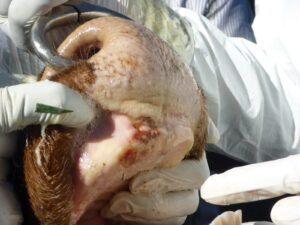Risks and Prevention Strategies for Foot and Mouth Disease in Canadian Cattle – Visit the New Webpage

Foot and Mouth Disease (FMD) is a highly infectious virus that has disastrous consequences on the livestock industry and the population of beef cattle and other cloven-hoofed animals worldwide. Fortunately, Canada has achieved FMD-free status, but everyone must stay vigilant to the risks and be prompt in our response in case of a possible outbreak.
Although it is one of the most contagious animal diseases, the Foot and Mouth Disease virus can be eliminated when proper procedures are followed. In the case of an outbreak, the CFIA would use its “stamping out” policy to eradicate the virus. This includes, but is not limited to, the humane destruction of all infected and exposed animals, tracing to identify locations of potentially infected or exposed animals, disposal of contaminated carcasses or products and decontamination of infected premises.
Foot and Mouth Disease is a reportable disease in Canada. This means that any suspect cases must be reported to the Canadian Food Inspection Agency (CFIA) immediately.
How is Foot and Mouth Disease spread?
Once the Foot and Mouth Disease virus has established itself, it spreads very quickly and easily. The main routes of transmission are:

- Direct: animal-to-animal contact. It is important to note that animals not susceptible to FMD (e.g. horses, chickens, mice) may still be able to spread the virus to cloven hooved species. In addition, humans can also carry the virus in their respiratory tract for up to two days.
- Animal products: feeding contaminated meat, feed or waste to animals or feeding untreated milk to young animals.
- Mechanical transmission: bringing the virus into contact with animals via inanimate objects such as footwear, clothing, tools machinery, or vehicles.
- Air: the virus can be carried from farm to farm via wind.
What can beef producers do to protect Canadian livestock?
The prevention of an outbreak within Canadian borders is the responsibility of all Canadians. The Canadian Food Inspection Agency (CFIA), Canadian Border Services Agency, and all livestock industry stakeholders work together to ensure that Canada keeps its FMD-free status.
How Canadian farmers and ranchers can help:
- Establish on-farm biosecurity protocols.
- Practice good biosecurity when visiting other farms, auction marts, feedlots, livestock shows or any other location where animals are comingling.
- Becoming VBP+ trained and/or certified to become more familiar with risk management strategies for producers to mitigate the possibility of a biosecurity threat.
- Respect and follow recommendations and rules from Canadian Customs when returning from visiting abroad.
- Ensure all employees and visitors to the farm are following biosecurity protocols.
- Watch for any signs of FMD, and report to your veterinarian immediately upon suspicion of symptoms.
Due to there being multiple different serotypes of the FMD virus currently circulating worldwide, pre-emptive vaccination of Canadian cattle is not an option as vaccination against one strain of the virus does not guarantee protection. The CFIA is working to establish an FMD vaccine bank for Canada, which can be used in the event of an outbreak.
Understand the prevention and control strategies
Foot and mouth disease is not a public health or food safety concern. It is an animal disease and is not related to the disease caused by Coxsackie virus called Hand, Foot and Mouth Disease, which is common in children.
Learn more about Foot and Mouth Disease, including symptoms, diagnosis, biosecurity measures as well as what Canadas response to a potential outbreak would look like on the new webpage. Additional materials on risks and prevention of FMD in Canadian beef cattle are currently in the works, including educational videos, and will be added to the FMD webpage on BeefResearch.ca as soon as they’re available.
Sharing or reprinting BCRC posts is welcome and encouraged. Please credit the Beef Cattle Research Council, provide the website address, www.BeefResearch.ca, and let us know you have chosen to share the article by emailing us at info@beefresearch.ca.
Your questions, comments and suggestions are welcome. Contact us directly or spark a public discussion by posting your thoughts below.
